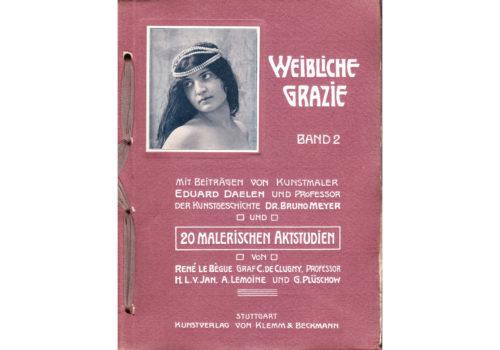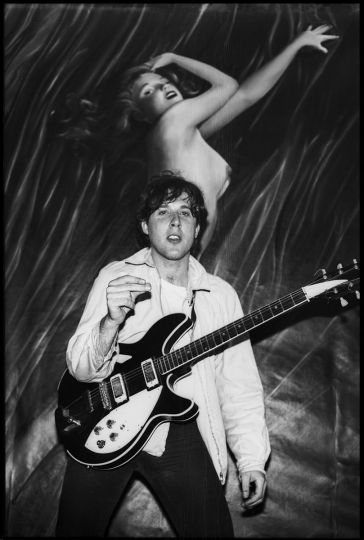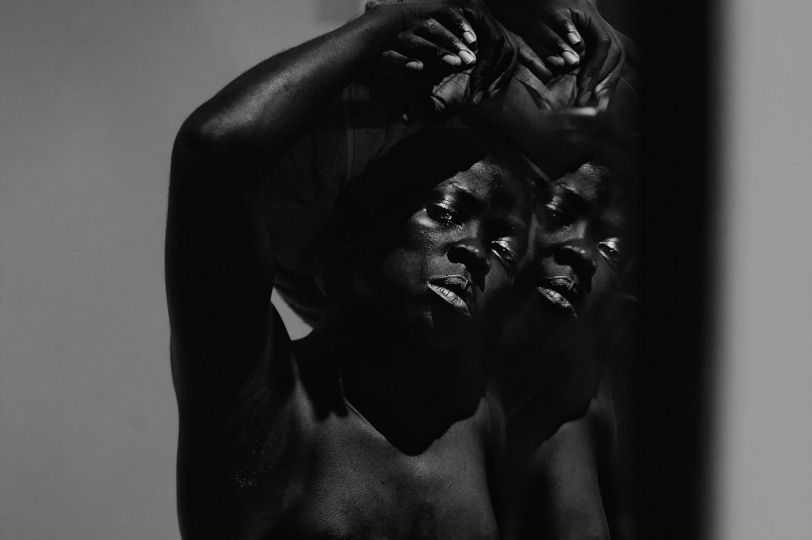The Eye of Photography is pleased to announce a new chronicle dedicated to 20th century nude photo books. We entrusted it to Alain-René Hardy, expert in Art Deco, who over the years has become the holder of a very important collection of books, brochures and periodicals illustrated by nude photography, an international reference recognized today by the specialists.
I renounce, ‒ momentarily, the very extensive and perilous presentation on female nude photographers during the interwar period that I had envisaged for this second column; it would have required more time than I have to give my prose and illustrations on time. I am therefore finally going to offer you an investigation, admittedly on a smaller scale but quite interesting, which has the advantage of being perfectly circumscribed, to meet the Count of Clugny, a fascinating amateur from the beginning of the 20th century. appreciated then and fallen into oblivion. Quite wrongly. Little is known about him, but eventually, thanks to Internet, some persistent and in-depth research will largely bring him out of his incognito.
The first time that, by chance, I noticed ‒ and greatly appreciated his photos, it was while leafing through one of my last purchases, a superb German publication from the beginning of the 20th century, entirely devoted (texts and photos) to the feminine nude. Published in 1904 in Stuttgart by the art publisher von Klemm & Beckmann, the five volumes of this series of “Weibliche Grazie” (Feminine Grace) constitute, thanks to the care given to their production, a product of undeniable luxury. ; everything contributes to it, from the elegant typography imposed on a beautiful laid paper to the photographic plates printed in duotone laminated on a strong colored Canson and protected by serpentes discreetly decorated with a pattern; to the refinement of the Japanese binding using a different colored ribbon for each volume (like the color of the cover). Provided by Bruno Meyer, art historian, photography enthusiast and author of studies on the nude, this enviable collection includes a total of 100 shots borrowed from the recent achievements of some of the most notable French and German photographers, thus providing a very informative of recent developments in artistic photography, particularly nude photography at the dawn of the 20th century.
Are thus highlighted two pillars of the Photo-club de Paris, René Le Bègue and A[chille] Lemoine, as well as Guglielmo Plüschow cousin and initiator of Baron von Gloeden and Hermann von Jan of Strasbourg, whose reputation was then growing. In addition, the second volume of this anthology [Ill. 1] also offered four photos of Graf (Count) C. de Clugny which conquered me both by the originality and the modernity of a look imbued with influences that evoke Rimbaud from Le Bateau ivre and Les Chants de Maldoror as well as surreal premonitions.
The first board [Ill. 2 & 3] indeed represents a young naked woman in sandals of leather straps in the antique style lying arms crossed under her head on the stony ground of a cave (interpreted as marine by some) her long hair scattered behind her head. It is neither a decor nor a usual posture in nude photography of the time, generally carried out partly in a studio, partly in a natural environment, ‒ the island of Herblay, for example, as did the group of “nudists” from the Photo-club de Paris‒; singularity here increased by the absence of obvious pictorialist treatments, in particular by retouching with gum bichromate.
The recognition of Clugny’s talent represented by this insertion is corroborated by three additional plates, two of which are in the same rock spirit; and the tendencies that we had noticed are confirmed and developed by the photograph on plate 11 [Ill. 4] for which the photographer, director, has laid his model down on a rock; undressed and abandoned, her back hugging the rough shape of the rocks, right arm dangling backwards, hair trailing to the gravel of the ground, like an Andromeda promised to a monstrous appetite… It is nevertheless not superfluous to underline that this motif, so singular, had been experienced long before him by his colleague Le Bègue [Ill. 5], the two shots, which Georges Arlaud remembered with the “Cariatide” from his “Nude studies” (1930), being almost similar in their content and treatment. Be that as it may, I was immediately seduced, even subjugated, by this daring way, of an almost sado-masochistic eroticism, of confronting by combining them, the tender and the hard, the hot and the cold, the soft curves and rough asperities, to which we owe these strong and provocative images.
A photo rather different in spirit, to be compared to the aesthetics of naturist spirit implemented by French nude photographers and many German practitioners, such as Schmidt and von Jan, then features a sylvan nymph, modestly draped in a muslin artfully arranged, threading her way through a thick wood between an enormous tree stump and a massive mossy rock [Ill. 6]; while plate n° 5 shows a young woman with long brown hair (it is also quite possible that it was the same model who posed for these four shots) standing attentively in a natural opening in the wall like thickness of a rock [Ill. 7].
There is more, this set of four photographs (of which we remain in the dark about the printing process) will be very precisely reused during the following years, in a very short period of time, by different publications, One in Germany ‒ Die Schönheit des menschlichen Körpers (The beauty of the human body) [Ill. 8] published in Stuttgart in 1905, followed by its second edition greatly increased by numerous articles and photos (Dusseldorf, v.1906) [Ill. 9], the other French, entitled “Feminine grace” [Ill. 10] published in 1907 by the Librairie technique et littéraire, compilation in hardcover of the 24 thematic issues of a bi-monthly review put into circulation throughout the year 1906.
The comparison between the reproductions of these three works tells us a lot about the commercial and artistic status of photography at this time, particularly in relation to printed publication. Because if the author of the photo is generally indicated, this is still not always the case, hence a lack of recognition of the authorship of the work. In addition, from one book to another the photos are sometimes cropped in width and/or height, or worse, reversed left/right, an undeniable betrayal of the creator’s intentions, and may have different titles (Marine Wreck of on one side, Dead on the other), or even captions due to the editor’s whim “Thin woman with a beautiful, very pronounced lumbar hollow”, where the others simply title “In the cave”. The quality of the reproductions, moreover, generally acceptable, presents however notable differences due to their variable dimensions, the skills of the photoengraver and the care of the printer and especially the type of reproduction used: as can be seen by comparing the same illustrations in the four collections, the first edition of Schönheit, which uses a duotone process, offers images with much more sharpness, more contrast and ultimately a greater presence, which give it in this respect an undeniable qualitative superiority.
From this point of view, the last work to reproduce photos of our photographer in which we will be interested, which actually appeared before (the beginning of 1902) all those previously mentioned, are technically very disappointing because of the smallness and mediocrity of the illustrations. But this study by C[harles] Klary, “La photographie du nu” [Ill. 11], (accessible on Gallica: https://gallica.bnf.fr/ark:/12148/bpt6k3410331d/f55.item.zoom ), very rich in terms of information, very opportunely completes our knowledge of the creations of Charles de Clugny.
There is indeed no reason to be surprised that this Parisian publisher specializing in photography assiduously frequented the exhibitions of the Photo-club in which de Clugny participated and was thus able to obtain easily and without intermediary the five photographs which illustrate his presentation. . If we find there some of the photos that will later be taken up by the German publishers, such as that on p. 39 (unfortunately inverted [Ill. 12], the author also offers three unpublished shots of Clugny, unknown elsewhere, which make it possible to better understand the subjects, the tastes and the inspiration of the count. This is how he reproduced the visions of a disheveled nymph jubilantly soaring “into the air” [Ill. 13], from “Repos de la bacchante”, lying naked on a rock surrounded by nature [Ill. 14] her abundant hair covering the ground; or the unnamed study of a naked woman, with her pelvis modestly veiled, leaning not against a rock, but against the rough trunk of a mighty forest [Ill. 15]. Everything here confirms the imperious attraction for the meeting of opposites, the visual signature of this original creator whose biography I will develop in my next talk.
Alain-René Hardy
[email protected]
Bibliography:
- Weibliche Grazie. 5 Klemm & Beckmann ; Stuttgart, 1904 ; 40 pp. d’études de B. Meyer et K. Wahr alternant avec 20 pl. de ph. contrecollées sur fort papier gaufré de couleur protégées par serpente imprimée. 27 x 20 cm. Relié à la japonaise par ruban sous couverture en papier fort gaufré de couleur. Photos de R. Le Bègue, H. von Jan, A. Lemoine, G. Plüschow. C. de Clugny (vol. 2). Chaque volume a une couverture et des supports de planches de couleurs différentes
- Die Schönheit des menschlichen Körper Klemm & Beckmann, Stuttgart, 1905, 152 pp. de texte (études de G. Fritsch, Daelen, B. Meyer,…) et une centaine de photos N&B (dont une sur 4 en pl. page). 28 x 19,5 cm. cartonné sous toile bleue à bords biseautés ; titre gaufré à l’or. Dans son emboîtage d’origine titré. Photos de R. Le Bègue, C. de Clugny, Freytag, H. Hildenbrand, H. von Jan, A. Lemoine, G. Plüschow, O. Schmidt, A. Schneider
- Die Schönheit des menschlichen Körpers. 2e éd. Ulrich & Steinbecher, Dusseldorf, d. (1906) ; 315 pp. de texte (études de G. Fritsch, Daelen, B. Meyer, J. Kirchner, G. de Téramond…) et 322 photos N&B dont beaucoup en pl. page (40 au total). 30,5 x 22,5 cm ; relié sous couv. toilée bordeaux à bords biseautés ; titre à l’or avec un médaillon allégorique gaufré doré.Photos de R. Le Bègue, C. de Clugny, Freytag, H. Hildenbrand, von Jan, A. Lemoine, G. Plüschow, O. Schmidt, A. Schneider ; Bataille, Cominetti et Agelou
- La beauté Librairie artistique et littéraire, Paris, s.d. (1907). 384 pp. de ph. N & B à raison de deux par page, et de 4 ph. pl. p. par livraison précédée d’un texte de 2 pages au début de chacun des 24 chap ; 26 x 18,5 cm, relié éditeur en toile crème avec lettres dorées et une photo de nu imprimée en noir. Les photos ne sont pas du tout créditées ; mais elles sont en grande partie issues de “L’étude académique” de Vignola et d’éditions allemandes. notamment J. Agélou, Schneider , Plüshow, de Clugny, Le Bègue, Lemoine et Büchler.
- Klary. La photographie du nu. C. Klary édr, Paris, 1902 (2e éd. 1906). 56 pp. d’études diverses sur le nu et 90 repr. de photos N & B. A la fin, nombreuses publicités relatives au matériele et fournitures photographiques. 28,5 x 20 cm ; broché sous couverture souple. Index p. 56 . Photos de Bergon, Boissonnas, de Clugny, Demachy, von Jan, Le Bègue, Plüschow, Puyo, O. Schmidt, Traut, Vignola
LÉGENDES DES ILLUSTRATIONS
- Couverture du tome 2 de Weibliche Grazie. 5 Klemm & Beckmann ; Stuttgart, 1904 ; 27 x 20 cm.
- Planche 1 de Weibliche Grazie recouverte de sa serpente imprimée
- In der Grotte, de C. de Clugny ; pl. 1 du tome 2 de Weibliche Grazie.
- Strandbeute, ph. de C. de Clugny ; in Die Schönheit des menschlichen Körpers. Klemm & Beckmann, Stuttgart, 1ère éd., 1905
- René Le Bègue. Sirène, photo exposée au salon du Photo-club de Paris en Repr. dans Die Kunst in der Photographie, Berlin, 1900 et par M. Poivert, Le pictorialisme en France, 1992.
- Waldnymphe, de C. de Clugny ; repr. in Die Schönheit des menschlichen Körpers. 2e éd. Ulrich & Steinbecher, Dusseldorf, s.d. (1906)
- Nu dans la percée, ph. de C. de Clugny ; in Die Schönheit des menschlichen Körpers. Klemm & Beckmann, Stuttgart, 1905
- Couverture de Die Schönheit des menschlichen Körpers. Klemm & Beckmann, Stuttgart, 1ère éd., 28 x 19,5 cm.
- Couverture de Die Schönheit des menschlichen Körpers. 2e éd. Ulrich & Steinbecher, Dusseldorf, s.d. (1906). 30,5 x 22,5 cm
- Couverture de La beauté Librairie artistique et littéraire, Paris, s.d. (1907). 26 x 18,5 cm
- Couverture de Klary. La photographie du nu. C. Klary édr, Paris, 1902 (2e éd. 1906). 28,5 x 20 cm
- “Morte”, de C. de Clugny ; repr. p. 39 de C. Klary. La photographie du nu. (Voir les Ill. 4 & 5)
- “Dans les airs”, de C. de Clugny ; repr. p. 41 de C. Klary. La photographie du nu.
- “Le repos de la bacchante”, de C. de Clugny ; repr. p. 14 de C. Klary. La photographie du nu.
- “Etude”, de C. de Clugny ; repr. p. 34 de C. Klary. La photographie du nu.
















